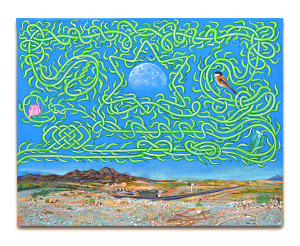Tim Razo
By Hope Ishear
Tim Razo has a style that knows no boundaries…an artist who indulges in multiple mediums while drawing on buses, exploring pop culture, and creating awareness through a recent series of Asarco posters. His attention to detail and design can be viewed through the use of neon colors that communicate his message of the southwest. Originally from California, Tim calls El Paso home and describes himself as a Southwestern multi-media artist.
 Hope: You refer to yourself as a “Southwestern” artist, but really what you do is take iconic pieces of the Southwest and transform them.
Hope: You refer to yourself as a “Southwestern” artist, but really what you do is take iconic pieces of the Southwest and transform them.
Tim: I grew up immersed in Southwestern art since I was a kid. It was everywhere. You’d go back in the 80s and I always dug the ideas behind the really good stuff I’d see. Even if it was just really skillfully delivered landscapes, I could understand the inspiration behind it because I’ve mostly lived in the desert my entire life. Most of my illustrations are usually mash-ups of ideas, but I keep my paintings and overall philosophy resonating with the Southwest. It’s a vision I have of progressing that feeling of desert psychedelia that keeps me stoked.
Hope: Your choice of colors is amazing…from paint to pencil. Tell me about your training.
 Tim: Getting high around the age of 14 to 21 while looking at art magazines and books I bought or stole from bookstores I think is what really ingrained that thought pattern of lucid colors. Now with 14 years of Photoshop color editing, filters and adjustments firmly established in my brain I think I just have solidified that ability. It’s a learning process which sometimes comes naturally and sometimes you have to really work at.
Tim: Getting high around the age of 14 to 21 while looking at art magazines and books I bought or stole from bookstores I think is what really ingrained that thought pattern of lucid colors. Now with 14 years of Photoshop color editing, filters and adjustments firmly established in my brain I think I just have solidified that ability. It’s a learning process which sometimes comes naturally and sometimes you have to really work at.
Hope: Some people have a centralized theme in their work, can you expand on yours?
Tim: As far as a message with my prints, illustrations, they’re usually just ideas that I have that range from pop culture to synchromysticsm (and everything in between). My paintings are usually more geared towards the idea of a symbiotic relationship between technology and nature. We’re coming to this point with technology that seems to be blurring the lines of human morality with GMOs, stem cell research, cloning, etc. I like exploring what’s past that a few hundred years down the line or so. So the Dreamcatchers for example, in my mind are GMOs gone wild. It’s a positive spin to something that people are usually up in arms about.
 Hope: What are you currently working on and what should we look for in the near future?
Hope: What are you currently working on and what should we look for in the near future?
Tim: I’m working on two large canvases that will be displayed in El Paso in October and then in Santa Fe by December to early 2014. The large canvases I’m working on are going to explore human technology even further. No murals in the near future from what I can tell. I’d like to work on more, I should probably be hitting the city up for funding.
Hope: What is the El Paso art scene missing, and how can you help bring awareness to the art community?
 Tim: If I was to say anything I would think El Paso’s art scene is missing a highly valued art market at the moment. It seems most people would rather buy their paintings or art that they surround themselves with from anonymous artists at furniture stores or thrift shops rather than buy authentic local art usually at lower prices. It’s a personal choice, but you have to get into the local game if you want to have a real local experience. Which is what you want to have especially if you’re looking to stay here a while. Locals need to be more aware of the value that local artists bring to the table.
Tim: If I was to say anything I would think El Paso’s art scene is missing a highly valued art market at the moment. It seems most people would rather buy their paintings or art that they surround themselves with from anonymous artists at furniture stores or thrift shops rather than buy authentic local art usually at lower prices. It’s a personal choice, but you have to get into the local game if you want to have a real local experience. Which is what you want to have especially if you’re looking to stay here a while. Locals need to be more aware of the value that local artists bring to the table.
Hope: Any comments you wish to add?
Tim: I would say a genuine study of psychology, the occult and origins of symbols and archetypes is a good thing to have under your belt if you are a visual artist.
You can view more of Tim’s work at: http://pazomotti.com

